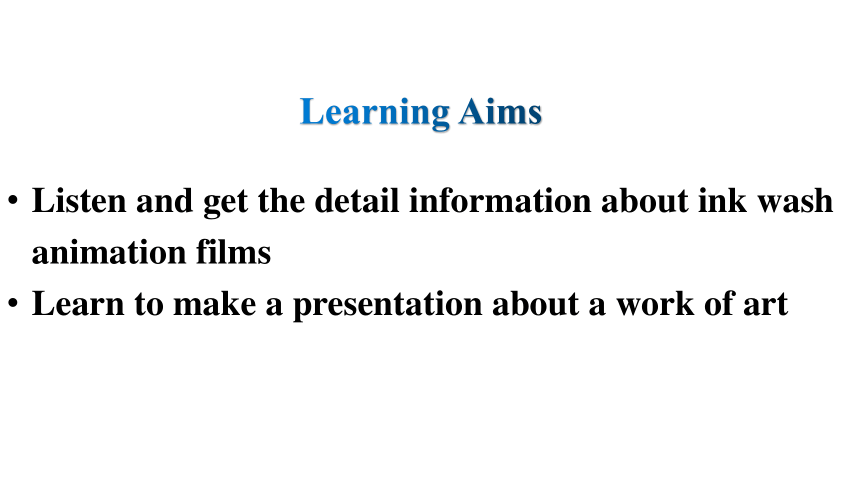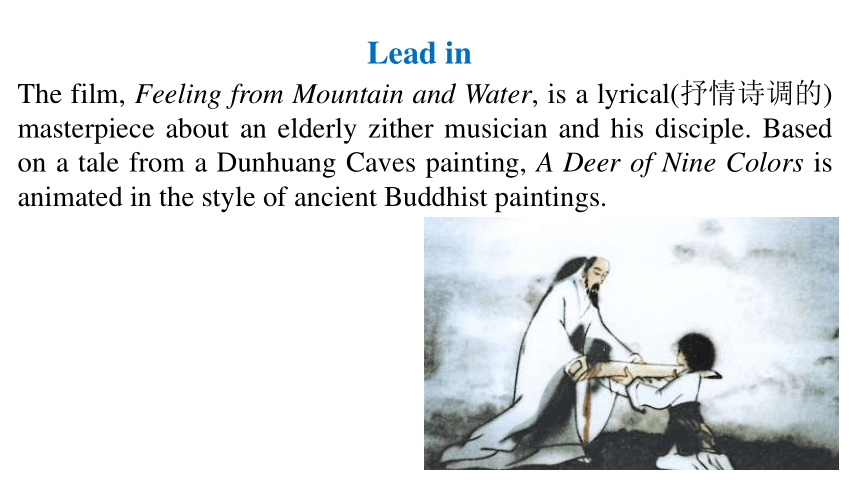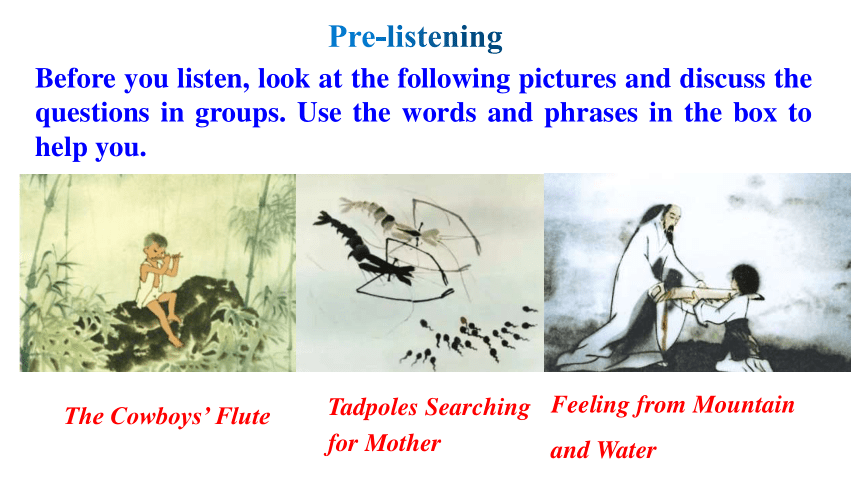人教版(2019)选择性必修 第三册Unit 1 Art Using language 1 课件(共21张,内嵌音视频)
文档属性
| 名称 | 人教版(2019)选择性必修 第三册Unit 1 Art Using language 1 课件(共21张,内嵌音视频) |  | |
| 格式 | pptx | ||
| 文件大小 | 13.2MB | ||
| 资源类型 | 教案 | ||
| 版本资源 | 人教版(2019) | ||
| 科目 | 英语 | ||
| 更新时间 | 2024-11-17 15:22:04 | ||
图片预览









文档简介
(共21张PPT)
Period 3 Using language(1)
Talk about works of art
Unit 1 Art
Listen and get the detail information about ink wash animation films
Learn to make a presentation about a work of art
Learning Aims
ink wash animation film
The film, Feeling from Mountain and Water, is a lyrical(抒情诗调的) masterpiece about an elderly zither musician and his disciple. Based on a tale from a Dunhuang Caves painting, A Deer of Nine Colors is animated in the style of ancient Buddhist paintings.
Lead in
In 1960, ink-and-wash animated films appeared in China and caught the attention of the world as a breakthrough in the forms of expression and aesthetic conception in animated films. Children's films in this period employ colorful means of expression. The special effects in the science fiction and fairy-tale films unfold a brand new world for children.
Tadpoles Searching for Mother received the Best Animated Film Prize at the 1st Hundred Flower Awards and five international prizes. The Crowboy’s Flute was awarded the Golden Prize at the Odense International Fairy Tale Film Festival in Denmark(丹麦).
Before you listen, look at the following pictures and discuss the questions in groups. Use the words and phrases in the box to help you.
The Cowboys’ Flute
Tadpoles Searching for Mother
Feeling from Mountain and Water
Pre-listening
These pictures are representatives of ink wash animation films. Have you seen any of them before What do you know about them
ink wash animation film, ink wash painting,
Qi Baishi, frame, Tadpoles Searching for Mother, The Cowboys’ Flute, symphony, hand-painted,
Feeling from Mountain and Water, guqin
Chinese cartoon films combine Chinese ancient painting, Dunhuang murals, murals in the Yongle Palace and colorful folk arts, like shadow play, paper-cut, and paper-cut for window decoration, and have developed cartoon film types like puppetoons(木偶片), ink-and-wash films and paper-cut films unique to China. Therefore, Chinese cartoon films are unique to China not only in content but also in form.
While-Listening
Listen to the presentation and put the following items in the order that you hear them.
_______________background of ink wash animation films
_____________a short review of the film
______________introduction to the topic of the presentation
________________a description of the story in the film
_________________an explanation of the decline in ink wash animation
2
4
1
3
5
Listen again and answer the questions.
1. Which film does the speaker mainly talk about
2. When were the three ink wash animation films produced
3. Why is the film regarded as a masterpiece of Chinese ink wash animation
4. What is the speaker’s attitude towards the ink wash animation style
5. How do you feel about this kind of film
1. Which film does the speaker mainly talk about
ink wash animation film
2. When were the three ink wash animation films produced
1960 Tadpoles Searching for Mother
1963 The Cowboy's Flute
1988 Feeling from Mountain and Water
3. Why is the film regarded as a masterpiece of Chinese ink wash animation
The film is not only appealing to the eyes and ears, but also rich in emotion.
4. What is the speaker’s attitude towards the ink wash animation style
He is fond of it and thinks it is unique and a traditional art form of Chinese painting.
5.How do you feel about this kind of film
As for me, I don’t show too much interest in this art form now, because I have grown up and don’t watch ink wash animation films any more.
Signpost markers are phrases and expressions that are used to tell a listener what is going to be talked about next. Speakers use signpost markers when they want to introduce a new topic, to start a new point, to give an example, to summarize, etc. By listening to signposts, you will be able to follow what is being said.
Listen for signpost markers
Making presentations
1.Introducing the topic
I'm glad to have this opportunity to ...
Today, I'd like to talk/speak (to you) about ...
My topic today is ...
I'd like to share some thoughts on ...
2.Starting a point
Let me/Let's start by ...
First, let me tell you about ...
I've divided my topic into ... parts: ...
Let's turn now to
3.Giving an example:
For instance, ...
For example,
Take .. for example, ...
Let me illustrate, ....
To illustrate, ...
Let me give you an example, ...
Today, I’d like to speak to you about…
Let’s start by talking about…
Following this,…
Finally,…
Let’s turn now to …
Signpost markers
Today, I’d like to speak to you about the ink wash animated film Feeling from Mountain and Water. Let’s start by talking about the background of ink wash animation, an animation style that is unique to China. This style combines Chinese traditional art with modern animation techniques.
In the late 1950s, inspired by the ink wash painter Qi Baishi, the Shanghai Animation Studio began toexplore ways to turn Chinese traditional paintings into cartoon form.
Listening text
The first ink wash animation film, Tadpoles Searching for Mother, was produced in 1960, and it received international praise. Following this, The Cowboy's Flute was produced in 1963, receiving the golden prize at an international film festival. Finally, in 1988, the ink wash animation masterpiece, Feeling from Mountain and Water was created. Let's turn now to the film itself. The film tells the simple story of an old musician and a young boy. In the film, an old musician falls ill while travelling and is helped by a young boy. To thank the boy, the musician teaches him how to play the guqin. With the change of the seasons, it is time for the musician to leave. As the musician says goodbye, he gives the boy his guqin, and then disappears into the mist.
Listening text
Listening text
Then, when the boy sits down to play the guqin, all of nature joins him in a visual symphony. The film has no dialogue. And, unlike typical cartoons, the film has no bright colours. In short, it is like a fine ink wash painting which has been brought to life a painting with movement. The animation and the music make the film not only appealing to the eyes and ears but also rich in emotion. Therefore, this 18-minute film is regarded by many as a masterpiece of Chinese ink wash animation. After the late 1980s, the high cost of producing ink wash animation caused film studios to stop making them.
The techniques used to produce such films simply required too much work, as each frame of the film had to be hand painted. However, in 2016, new artists have begun to make ink wash animated films using computers. It is hoped that these new techniques will breathe new life into this art form.
Listening text
Behind every successful man there’sa lot of unsuccessful years.
每个成功者的后面都有很多不成功的岁月。
Period 3 Using language(1)
Talk about works of art
Unit 1 Art
Listen and get the detail information about ink wash animation films
Learn to make a presentation about a work of art
Learning Aims
ink wash animation film
The film, Feeling from Mountain and Water, is a lyrical(抒情诗调的) masterpiece about an elderly zither musician and his disciple. Based on a tale from a Dunhuang Caves painting, A Deer of Nine Colors is animated in the style of ancient Buddhist paintings.
Lead in
In 1960, ink-and-wash animated films appeared in China and caught the attention of the world as a breakthrough in the forms of expression and aesthetic conception in animated films. Children's films in this period employ colorful means of expression. The special effects in the science fiction and fairy-tale films unfold a brand new world for children.
Tadpoles Searching for Mother received the Best Animated Film Prize at the 1st Hundred Flower Awards and five international prizes. The Crowboy’s Flute was awarded the Golden Prize at the Odense International Fairy Tale Film Festival in Denmark(丹麦).
Before you listen, look at the following pictures and discuss the questions in groups. Use the words and phrases in the box to help you.
The Cowboys’ Flute
Tadpoles Searching for Mother
Feeling from Mountain and Water
Pre-listening
These pictures are representatives of ink wash animation films. Have you seen any of them before What do you know about them
ink wash animation film, ink wash painting,
Qi Baishi, frame, Tadpoles Searching for Mother, The Cowboys’ Flute, symphony, hand-painted,
Feeling from Mountain and Water, guqin
Chinese cartoon films combine Chinese ancient painting, Dunhuang murals, murals in the Yongle Palace and colorful folk arts, like shadow play, paper-cut, and paper-cut for window decoration, and have developed cartoon film types like puppetoons(木偶片), ink-and-wash films and paper-cut films unique to China. Therefore, Chinese cartoon films are unique to China not only in content but also in form.
While-Listening
Listen to the presentation and put the following items in the order that you hear them.
_______________background of ink wash animation films
_____________a short review of the film
______________introduction to the topic of the presentation
________________a description of the story in the film
_________________an explanation of the decline in ink wash animation
2
4
1
3
5
Listen again and answer the questions.
1. Which film does the speaker mainly talk about
2. When were the three ink wash animation films produced
3. Why is the film regarded as a masterpiece of Chinese ink wash animation
4. What is the speaker’s attitude towards the ink wash animation style
5. How do you feel about this kind of film
1. Which film does the speaker mainly talk about
ink wash animation film
2. When were the three ink wash animation films produced
1960 Tadpoles Searching for Mother
1963 The Cowboy's Flute
1988 Feeling from Mountain and Water
3. Why is the film regarded as a masterpiece of Chinese ink wash animation
The film is not only appealing to the eyes and ears, but also rich in emotion.
4. What is the speaker’s attitude towards the ink wash animation style
He is fond of it and thinks it is unique and a traditional art form of Chinese painting.
5.How do you feel about this kind of film
As for me, I don’t show too much interest in this art form now, because I have grown up and don’t watch ink wash animation films any more.
Signpost markers are phrases and expressions that are used to tell a listener what is going to be talked about next. Speakers use signpost markers when they want to introduce a new topic, to start a new point, to give an example, to summarize, etc. By listening to signposts, you will be able to follow what is being said.
Listen for signpost markers
Making presentations
1.Introducing the topic
I'm glad to have this opportunity to ...
Today, I'd like to talk/speak (to you) about ...
My topic today is ...
I'd like to share some thoughts on ...
2.Starting a point
Let me/Let's start by ...
First, let me tell you about ...
I've divided my topic into ... parts: ...
Let's turn now to
3.Giving an example:
For instance, ...
For example,
Take .. for example, ...
Let me illustrate, ....
To illustrate, ...
Let me give you an example, ...
Today, I’d like to speak to you about…
Let’s start by talking about…
Following this,…
Finally,…
Let’s turn now to …
Signpost markers
Today, I’d like to speak to you about the ink wash animated film Feeling from Mountain and Water. Let’s start by talking about the background of ink wash animation, an animation style that is unique to China. This style combines Chinese traditional art with modern animation techniques.
In the late 1950s, inspired by the ink wash painter Qi Baishi, the Shanghai Animation Studio began toexplore ways to turn Chinese traditional paintings into cartoon form.
Listening text
The first ink wash animation film, Tadpoles Searching for Mother, was produced in 1960, and it received international praise. Following this, The Cowboy's Flute was produced in 1963, receiving the golden prize at an international film festival. Finally, in 1988, the ink wash animation masterpiece, Feeling from Mountain and Water was created. Let's turn now to the film itself. The film tells the simple story of an old musician and a young boy. In the film, an old musician falls ill while travelling and is helped by a young boy. To thank the boy, the musician teaches him how to play the guqin. With the change of the seasons, it is time for the musician to leave. As the musician says goodbye, he gives the boy his guqin, and then disappears into the mist.
Listening text
Listening text
Then, when the boy sits down to play the guqin, all of nature joins him in a visual symphony. The film has no dialogue. And, unlike typical cartoons, the film has no bright colours. In short, it is like a fine ink wash painting which has been brought to life a painting with movement. The animation and the music make the film not only appealing to the eyes and ears but also rich in emotion. Therefore, this 18-minute film is regarded by many as a masterpiece of Chinese ink wash animation. After the late 1980s, the high cost of producing ink wash animation caused film studios to stop making them.
The techniques used to produce such films simply required too much work, as each frame of the film had to be hand painted. However, in 2016, new artists have begun to make ink wash animated films using computers. It is hoped that these new techniques will breathe new life into this art form.
Listening text
Behind every successful man there’sa lot of unsuccessful years.
每个成功者的后面都有很多不成功的岁月。
